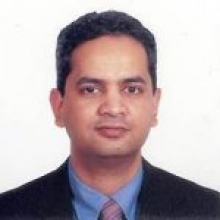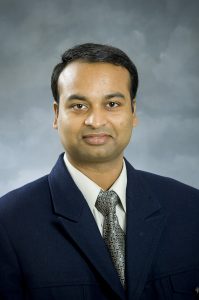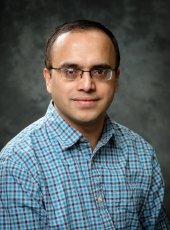 SUKUMAR KAMALASADAN
SUKUMAR KAMALASADANEnergy Storage Management and integration in the power distribution systems with PV farms
In this tutorial, various approaches for battery energy storage management and integration in power distribution system are discussed. First, main advantages of using grid connected energy storage with PV farms are illustrated. This includes methods of using energy storage for: a) Smoothing intermittent PV outputs, b) Regulating distribution system voltage, c) Supporting energy time shift and, d) Supporting frequency regulation. Then a methodology to stack these applications to maximize energy usage of the storage is discussed. Important considerations are to optimize the energy storage state-of-charge and prioritize the applications based on optimal value streams. Finally, considerations for using energy storage for net-load and substation power management are discussed along with battery degradation and life cycle improvement characteristics.
Real Time and Distributed Control of Modern Power Grid
This tutorial mainly focuses on real-time and distributed control of modern power grid. In this talk, first the approaches for real-time control in transmission systems especially using measurements and wider area signals are discussed. This includes real-time measurements, data concentration, signal identification and selection, and damping controller design for oscillation mitigations. Then, an approach for distributed control is illustrated that can identify local area oscillations in each part of the power network. A methodology for applying this architecture for mitigating voltage and frequency oscillation in power grid is illustrated. Real-time implementation architecture of the proposed methodology is discussed that shows how the signal selection and grouping can be achieved online. The talk ends by discussing the application of these techniques in power distribution systems.
Short Bio
Prof. Sukumar Kamalasadan (M’04, SM’17) is currently a Professor in the Department of Electrical and Computer Engineering and an Associate of the Energy Production and Infrastructure Center, University of North Carolina at Charlotte, Charlotte, NC, USA. He received the B.Tech. degree in electrical and electronics engineering from the University of Calicut, India, in 1991, the M.Eng. degree in electric power system management from the Asian Institute of Technology, Thailand, in 1999, and the Ph.D. degree in electrical Engineering from the University of Toledo, Toledo, USA, in 2004. He has combined 25 years of experience in industry and academia in power systems. He has published more than 140 research articles and attracted ~3 million dollars in research funding. His research interests include smart grid, micro grid, power system operation and optimization, power system dynamics, stability and control, and renewable-energy-based distributed generation.
Prof. Kamalasadan is an Associate Editor and paper review chair of the IEEE Transactions on Industry Applications. He was a recipient of several awards, including the National Science Foundation Faculty Early CAREER Award in 2008, best paper awards from IEEE in 2015 and 2017 and, outstanding teaching awards. He is a Senior Member of the IEEE and a member of IEEE Power and Energy Society, IEEE Control Systems Society, IEEE Industrial Electronics Society, IEEE Computational Intelligence Society, IEEE Power Electronics Society and IEEE Industrial Applications Society. Prof. Kamalasadan is the past-chair of the IEEE Life Long Learning Subcommittee (LLLSC) having served as the Secretary, Vice-Chair and Chair, Inaugural Chair of Selection and Quality Control Subcommittee, and member of New Product and Development Committee both newly formed under IEEE PES VP for Education. He is also a member of IEEE PES oscillation location taskforce committee, co-chair for subtask under the oscillation location task force, a member of dynamic equivalent systems taskforce, a past member of intelligent systems subcommittee, and past chair for IEEE PES Charlotte section. For more details please visit, https://coefs.uncc.edu/skamalas/
 ANURAG SIRIVASTAVA
ANURAG SIRIVASTAVAKeeping the power on to critical facilities such as hospitals and fire department during extreme weather events, cyber events and other electric grid disruptions is essential. Microgrids improve the reliability of the critical loads in natural disasters and grid disturbances. With additional planning and design, microgrid can also help to restore critical loads outside microgrid and hence increase the system resiliency. There is a need for formal metrics to quantify resiliency of the different distribution system, or different configurations of the same network. This tutorial presents a tool to study the cyber-physical resiliency of the active distribution system for planning phase and operational phase. The resiliency metric is formulated based on graph theoretic metrics and power system constraints. The information from these two phases is provided to the operator to make informed and proactive decisions to ensure the resilient operation of the electric power system.
With the ongoing investments in smarter electric grid, several new algorithms and devices have been developed. Synchrophasors devices provide synchronized measurements at faster rates for enhanced wide area situational awareness enabling number of new data-driven applications. Model validation, asset failure diagnosis, state estimation, load modeling, voltage stability are some of the synchrophasor applications. Data quality needs to be ensured before using this data for critical system operation and control applications. Data available through automation also provide opportunity for analyzing cyber-intrusions and designing cyber defense mechanism. This tutorial will discuss about data-quality solutions and several synchrophasors data-driven algorithms for transmission system using synchrophasors including consideration of cyber-physical systems.
Anurag K. Srivastava is an associate professor of electric power engineering at Washington State University and the director of the Smart Grid Demonstration and Research Investigation Lab (SGDRIL) within the Energy System Innovation Center (ESIC). He received his Ph.D. degree in electrical engineering from the Illinois Institute of Technology in 2005. In past years, he has worked in different capacity at the Réseau de transport d´électricité in France; RWTH Aachen University in Germany; Idaho National Laboratory, Pacific Northwest National Lab, PJM Interconnection, Schweitzer Engineering Lab (SEL), GE Grid Solutions, Massachusetts Institute of Technology and Mississippi State University in USA; Indian Institute of Technology Kanpur in India; as well as at Asian Institute of Technology in Thailand. His research interest includes data-driven algorithms for power system operation and control including resiliency analysis. Dr. Srivastava is a senior member of the IEEE, vice-chair of IEEE PES PEEC committee, co-chair of the microgrid working group, secretary of PES voltage stability working group, chair of PES synchrophasors applications working group, past-chair of the IEEE PES career promotion subcommittee, past-chair of the IEEE Power & Energy Society’s (PES) student activities committee, and past vice-chair of the IEEE synchrophasor conformity assessment program. Dr. Srivastava is an editor of the IEEE Transactions on Smart Grid, IEEE Transactions on Power System, IET Generation, Transmission and Distribution and Elsevier Sustainable Computing. He is an IEEE distinguished lecturer and delivered more than 50 keynote/ plenary or tutorial in 20 countries, and authored more than 250 technical publications including a book on power system security and 4 pending/ awarded patents.
 SUMIT PAUDYAL
SUMIT PAUDYALOptimization Applications in Power System (2 hours): This session will cover general problem formulation and mathematical analysis of Unit Commitment, Economic Load Dispatch, and Optimal Power Flow with academic examples. The concept of Locational Marginal price will also be discussed.
Introduction to Optimization Tools (2 hours): This session will cover use off-the-shelf modeling tools, such as GAMS, AMPL, JuliaOpt, and example power system problems will be solved using state-of-the-art solvers.
Sumit Paudya: (S’07, M’13) received the M.Sc. from the University of Saskatchewan, Canada, in 2008; and the PhD. from the University of Waterloo, Canada, in 2012, all in Electrical Engineering. He joined the Department of Electrical Engineering, Michigan Technological University, USA, as an Assistant Professor in 2012. His current research interests include distribution grid operations, power system protection, power system real-time hardware simulations, and optimization techniques.
